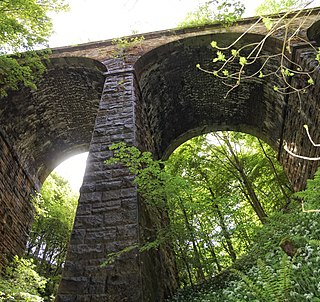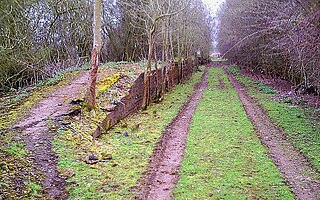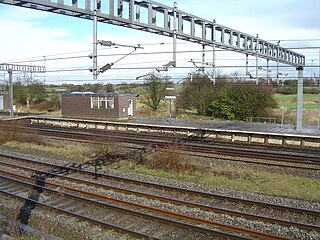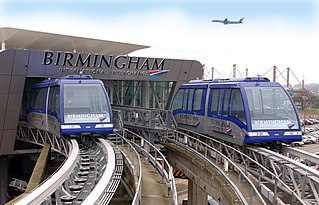British Railways (BR), which from 1965 traded as British Rail, was a state-owned company that operated most rail transport in Great Britain from 1948 to 1997. Originally a trading brand of the Railway Executive of the British Transport Commission, it became an independent statutory corporation in January 1963, when it was formally renamed the British Railways Board.

The Beeching cuts were a major series of route closures and service changes made as part of the restructuring of the nationalised railway system in Great Britain in the 1960s. They are named for Richard Beeching, then-chair of the British Railways Board and the author of two reports – The Reshaping of British Railways (1963) and The Development of the Major Railway Trunk Routes (1965) – that outlined the necessity of improving the efficiency of the railways and the plan for achieving this through restructuring.
The Rail Delivery Group Limited (RDG), previously the Association of Train Operating Companies, is the British rail industry membership body that brings together passenger and freight rail companies, Network Rail and High Speed 2. The RDG is approximately half-funded by Network Rail, the remainder of its funding being provided by the various transport groups it represents.

The Hope Valley line is a trans-Pennine railway line in Northern England, linking Manchester with Sheffield. It was completed in 1894.
The privatisation of British Rail was the process by which ownership and operation of the railways of Great Britain passed from government control into private hands. Begun in 1994, the process was largely completed by 1997. The deregulation of the industry was in part motivated by the enactment of EU Directive 91/440 in 1991, which aimed to create a more efficient railway network by creating greater competition.

An abandonedrailway station is a building or structure which was constructed to serve as a railway station but has fallen into disuse. There are various circumstances when this may occur – a railway company may fall bankrupt, or the station may be closed due to the failure of economic activity such as insufficient passenger numbers, operational reasons such as the diversion or replacement of the line. In some instances, the railway line may continue in operation while the station is closed. Additionally, stations may sometimes be resited along the route of the line to new premises – examples of this include opening a replacement station nearer to the centre of population, or building a larger station on a less restricted site to cope with high passenger numbers.

Doncaster Sheffield Airport, formerly named and commonly referred to as Robin Hood Airport, is a former international airport in Finningley near Doncaster in South Yorkshire, England, in operation between 2005 and 2022. The site lies 6 mi (10 km) south-east of the centre of Doncaster and 19 mi (31 km) east of Sheffield.

The Office of Rail and Road (ORR) is a non-ministerial government department responsible for the economic and safety regulation of Britain's railways, and the economic monitoring of National Highways.

The Federal Railroad Administration (FRA) is an agency in the United States Department of Transportation (DOT). The agency was created by the Department of Transportation Act of 1966. The purpose of the FRA is to promulgate and enforce rail safety regulations, administer railroad assistance programs, conduct research and development in support of improved railroad safety and national rail transportation policy, provide for the rehabilitation of Northeast Corridor rail passenger service, and consolidate government support of rail transportation activities.
A parliamentary train was a passenger service operated in the United Kingdom to comply with the Railway Regulation Act 1844 that required train companies to provide inexpensive and basic rail transport for less affluent passengers. The act required that at least one such service per day be run on every railway route in the UK.

Norton Bridge railway station was a railway station located on the West Coast Main Line and served both the village of Norton Bridge and the town of Eccleshall in Staffordshire, England.
The Wealden Line is a partly abandoned double track railway line in East Sussex and Kent that connected Lewes with Tunbridge Wells, a distance of 25.25 miles (40.64 km). The line takes its name from the Weald, the hilly landscape the lies between the North and South Downs.

Heathrow Airtrack was a proposed railway link in the United Kingdom which would link Heathrow Airport in west London to London Waterloo railway station in Central London.

A rail replacement bus service uses buses to replace a passenger train service on a temporary or permanent basis. The train service that is replaced may be of any type such as light rail, tram, streetcar, commuter rail, regional rail or heavy rail, intercity passenger service. The rail service may be replaced if the line is closed because of rail maintenance, a breakdown of a train, a rail accident or a strike action or to simply provide additional capacity or if the rail service is not economically viable.

Sydney Metro Northwest was a rapid transit project that constructed the first section of the Metro North West Line through the north-western suburbs of Sydney, New South Wales, Australia. The project included the conversion of the existing Epping to Chatswood rail link to metro standards and connects the suburbs of Rouse Hill and Chatswood via Castle Hill and Epping. The project was managed by Transport for NSW. The completed Metro North West Line opened on the 26 May 2019.

The Air-Rail Link is a people mover linking Birmingham Airport with Birmingham International railway station and the National Exhibition Centre in England. The current system, originally known as SkyRail, replaced the earlier Birmingham Maglev system in 2003.

Andrew George Stephenson is a British politician serving as Minister of State for Health and Secondary Care since November 2023. A member of the Conservative Party, he has been the Member of Parliament (MP) for Pendle in Lancashire since 2010.

Newhaven Marine railway station was a station in Newhaven, East Sussex, England, at the end of a short branch off the Seaford branch line near Newhaven Harbour. It was the last station to open in Newhaven, in 1886, following redevelopment and expansion of the Port of Newhaven and served cross-Channel boat trains to Dieppe, France.
Some railway stations in the United Kingdom have no services on offer from them, which renders the station effectively closed. These stations do not appear in the rail usage figures of the Office of Rail & Road as the stations receive no passengers. In order for the station to officially close, the Department for Transport is required to launch a consultation process before formally closing, under the provisions of the Railways Act 2005.

Lesley Margaret Laird is a Scottish politician who served as Deputy Leader of the Scottish Labour Party from 2017 to 2019. She was Member of Parliament (MP) for Kirkcaldy and Cowdenbeath from 2017 to 2019, and Shadow Secretary of State for Scotland during the same period. Laird was a Member of Fife Council from 2012 to 2018 and served as the Deputy Leader of the Council.













